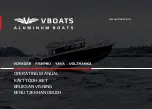
Owner’s Manual Page 43
Basic Seamanship - Section C
buoys have a cone shaped top with their points
cut off. Do not pass too close to a buoy. You may
foul the propeller in its chain.
NOTICE
Buoys are anchored floating objects and may
not always be in exactly the same position.
Daymarks are red or green boards with numbers.
They are on posts or groups of pilings tied together
and called dolphins. Daymarks and their supports
are daybeacons. Daybeacons may or may not have
lights. If a red or green daybeacon has a light, it is
the same color as the marker-red or green. Red
daymarks are triangular and have even numbers.
Green daymarks are square and have odd numbers.
Red Right Returning
is a basic rule to assist you in
using lateral markers. When you are returning from
seaward, keep red markers on the starboard (right)
side when you pass them. Keep green markers to
the port side.
Returning from seaward is very clear if you have
been on the ocean. You are returning to port. By
agreement, going upstream on a navigational river is
returning from seaward. The outlet ends of the Great
Lakes are also the seaward ends. Traveling from a
large body of water to a smaller one is considered
returning from seaward.
C. Safe Water Markers
Safe water markers have vertical red and white
stripes and mark the center of navigable channels
and fairways. Safe water markers included both
lighted and unlighted buoys and daymarks. If a
marker is lighted, the light is white and flashes the
letter “A” is Morse Code.
Preferred Channel markers have horizontal red and
green bands. If lighted, the color of the light is the
same as the top of the band. They show the pre-
ferred channel for you to use at a junction point. Be
sure to notice the color of the top of the band, and
treat it as any other marker you would of that color.
If the band is red and you are returning from sea-
ward, keep the marker to the right.
Most lights on markers flash on and off. Others such
as lights on aids with no lateral significance are fixed.
They stay on all night. ATON lights flash in regular
patterns. For example, they may flash every three
blasts) if intent is not clear. A short blast is one or two
seconds long. A long blast is 4 to 6 seconds long. The
Navigational Aids Chart at the end of this section lists
the meanings of the various whistle signals.
C - 2 NAVIGATIONAL AIDS
Aids to navigation (ATONS) help you to travel safely on
the water. They help you get from one place to another
and are most helpful if you have a nautical chart. A
navigational aids chart is at the end of this section.
NEVER tie your vessel to an ATON. It is illegal
because it blocks the ATON from view of other
boaters. Decreased visiblility can contribute to
a serious accident which may result in property
damage, personal injury, or death.
There are two ATON systems. The system used on
federal waters is known as the International Associa-
tion of Lighthouse Authorities System B (IALA-B).
The Coast Guard maintains this system. The second
system is the Uniform State Waterway Marking System
(USWMS). This system is maintained by state
authorities.
A. International Association of Lighthouse
Authorities System B (IALA-B)
IALA-B uses four types of ATONS. This section
discusses the two most common markers: lateral
markers and safe water markers. Other federal
markers include special markers and isolated danger
markers. The Navigational Aids Chart at the end
of this section shows these aids.
B. Lateral Markers
NOTICE
Marker colors only apply in North America.
Lateral markers indicate the sides of navigable
channels. They consist of lighted can or nun buoys
and daymarks. Each has a number and is either red
or green. The numbers on the green markers are odd.
Red markers have even numbers.
Buoys are red or green floating ATONS. If lighted, they
have either red or green lights. Unlighted green buoys,
called cans, look like cylinders. Unlighted red nun
Summary of Contents for V458
Page 1: ...V 4 5 8 O W N E R S M A N U A L 0 9 0 2 8 8 6 ...
Page 2: ......
Page 4: ...Table of Contents Owner s Manual Page 1 Table of Contents ...
Page 5: ...Owner s Manual Page 2 Table of Contents ...
Page 6: ...Table of Contents Owner s Manual Page 3 ...
Page 7: ...Owner s Manual Page 4 Table of Contents ...
Page 8: ...Table of Contents Owner s Manual Page 5 ...
Page 9: ...Owner s Manual Page 6 Table of Contents ...
Page 10: ...Table of Contents Owner s Manual Page 7 ...
Page 11: ...Owner s Manual Page 8 Table of Contents ...
Page 52: ...Owner s Manual Page 50 Warranty and Service Section D ...
Page 54: ...Owner s Manual Page 52 Warranty and Service Section D ...
Page 94: ...Owner s Manual Page 92 Fuel Systems Section I Figure I9 Fuel Valve System Components ...
Page 171: ...Owner s Manual Page 169 Pre Launch and Underway Section S Figure S3 Mooring Lines ...
Page 188: ......
Page 189: ...www fourwinns com ...
















































